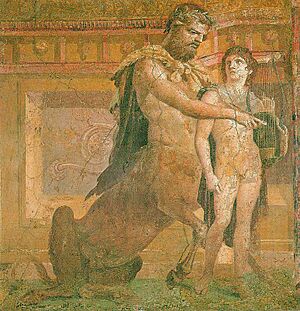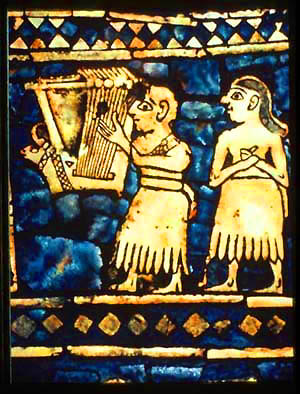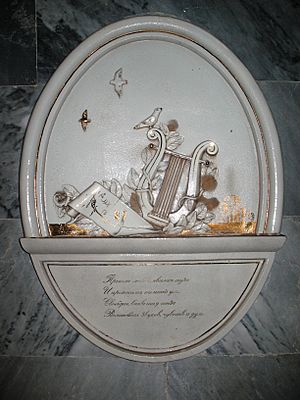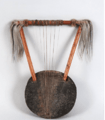Lyre facts for kids
A lyre (say "LY-er", rhymes with "fire") is an ancient musical instrument. It's a bit like a harp or a guitar. You hold it with one hand and pluck or strum its strings with the other. Lyres were some of the very first string instruments ever made!
Contents
What is a Lyre?
A classical lyre has a hollow body, often called a sound-chest or soundbox. In ancient Greece, this part was sometimes made from a turtle shell. Two arms extend up from the sound-chest. These arms are connected at the top by a crossbar, also called a yoke.
Another crossbar, attached to the sound-chest, acts as a bridge. This bridge helps the strings' vibrations travel into the sound-chest, making the sound louder. The strings were usually made from animal gut. They stretched from the yoke down to the bridge.
How Lyres Were Tuned
There were two main ways to tune a lyre:
- Strings could be tied to pegs that could be turned.
- The string's position on the crossbar could be changed.
It's likely that both methods were used together.
The Lyre's Mythical Beginning
According to ancient Greek mythology, the god Hermes invented the lyre. The story says that young Hermes stole some sacred cows from Apollo. To avoid being caught, he made the cows walk backward. Apollo couldn't follow their tracks.
Along the way, Hermes sacrificed one cow. He used its entrails (insides) and a tortoise shell to create the first lyre. When Apollo found Hermes, he was very angry. But when he heard the beautiful sound of the lyre, his anger disappeared. Apollo offered to trade his herd of cattle for the lyre. This is why Hermes is often given credit for creating the lyre. Some stories, however, say Apollo himself invented it.
Where Lyres Were Used
Lyres were important in many ancient cultures. They were used in southern Europe, western Asia, and northern Africa. Today, you can still find lyres being played in parts of north-eastern Africa.
Ancient Greek colonies in Asia Minor (modern-day Turkey) also used and developed the lyre. The ancient Greeks called some Egyptian box instruments kissar, which is similar to their word for lyre, cithara. This shows that Greeks saw similarities between their lyres and instruments from Egypt. This suggests that the lyre might have come to Greece from neighboring countries like Thrace, Lydia, or Egypt a long time ago.
Playing the Lyre
Ancient lyres did not have a fingerboard, which is a flat piece of wood where you press strings down to change notes (like on a guitar). This also meant a bow (like on a violin) couldn't be used.
Players used a pick, called a plectrum, in their right hand to strum the upper strings. When not in use, the plectrum would hang from the instrument by a ribbon. The fingers of the left hand would touch the lower strings. This was probably to stop unwanted notes from ringing out.
The number of strings on a classical lyre changed over time and in different places. Four, seven, and ten strings were common numbers.
Types of Lyres
Some experts group lyres with the zither family. This family includes many stringed instruments like lutes, guitars, and psalteries.
However, other experts believe lyres and zithers are different. They say zithers have strings spread across most of their soundboard. Lyres, on the other hand, have strings that come from a single point, like a tailpiece. For example, a piano is a type of zither, while a violin is sometimes called a type of lyre.
Some experts even say that instruments like the violin and guitar are in a separate group called the lute class. This is because they don't have the upright arms (yokes) that "true" lyres have. But others call instruments like the violin and guitar "independent fingerboard lyres."
Other Instruments Called Lyres
The famous lyres of Ur were found in ancient Mesopotamia (modern Iraq). They date back to 2500 BC and are thought to be the oldest surviving stringed instruments in the world.
Over time, the word "lyre" in the Greek world also came to mean bowed instruments, like the Byzantine lyra and the Cretan lyra.
Lyres in Europe
Lyres were also made and used in Europe outside of the Greek and Roman world. In 2010, parts of a 2,300-year-old lyre were found on the Isle of Skye, Scotland. This makes it Europe's oldest surviving stringed musical instrument.
Lyres became more common in the early Middle Ages. Some people think many modern stringed instruments developed from these early lyres. There's no clear proof that non-Greek lyres were only played with picks. Many instruments now considered modern lyres are played with bows.
Lyres that developed separately from Greek and Roman styles were used by Germanic and Celtic people over a thousand years ago. The oldest known pieces of these instruments are from around the 6th century AD.
When the bow arrived in Europe from the Middle East about 200 years later, it was used on smaller lyres. This led to two main types of bowed European lyres:
- Those with fingerboards that divided the space inside the yoke.
- Those without fingerboards.
The last instruments of the second type were the Scandinavian talharpa and the Finnish jouhikko. Players could change notes by pressing their fingernails against the strings.
The last bowed lyre with a fingerboard was the "modern" (around 1485–1800) Welsh crwth. It had earlier versions in Britain and Europe. To change pitch, players pressed the string firmly against the fingerboard with their fingertips. This made the vibrating part of the string shorter, creating higher notes. This is the same idea used in modern violins and guitars.
While experts still debate how European bowed lyres developed, they generally agree that these instruments were not the direct ancestors of modern orchestral string instruments like the violin.
 |
 |
|
|
Left image: Silenus holding a lyre, detail of a fresco from the Villa of the Mysteries, Pompeii, Italy, c. 50 BC
Right image: Cupids playing with a lyre, Roman fresco from Herculaneum |
||
Lyre Variants Around the World
Many cultures have their own versions of the lyre.
- Europe
- Armenia: քնար (knar)
- British Isles: the Scottish gue and cruit, the Welsh crwth, the English rote or crowd
- Continental Europe: Germanic or Ango-Saxon lyre (hearpe), rotte or crotte
- Estonia: talharpa
- Finland: jouhikko
- Greece: λύρα (lýra; Modern Greek pronunciation: líra) with types like Politiki lyra ("Constantinopolitan lyre"), Cretan lyra and Pontic lyra ("lyre of the Black Sea", also known as kemençe)
- Italy: the Latin chorus, the modern Calabrian lira
- Lithuania: lyra
- Norway: giga
- Poland: lira
- Asia
- Arabian peninsula: tanbūra
- Bangladesh: ektara
- India: ektara
- Iran: chang
- Iraq: sammu, tanbūra, zami, zinar
- Israel: kinnor
- Nepal: sarangi
- Pakistan: barbat, ektara, tanbūra
- Siberia: nares-jux
- Yemen: tanbūra, simsimiyya
- Africa
- Egypt: kissar, tanbūra, simsimiyya
- Ethiopia and Eritrea: begena, dita, krar
- Kenya: kibugander, litungu, nyatiti, obokano
- Sudan: kissar, tanbūra
- Tanzania: litungu
- Uganda: endongo, ntongoli
Images for kids
-
This Mycenaean sarcophagus from 14th century BC shows an early lyre with seven strings.
-
A Nubian person playing a Tanbūra in Cairo, 1858.
-
A painting of a Lyre Player from the Deccan sultanates, around 1640-1660.
See also
 In Spanish: Lira (instrumento musical) para niños
In Spanish: Lira (instrumento musical) para niños












